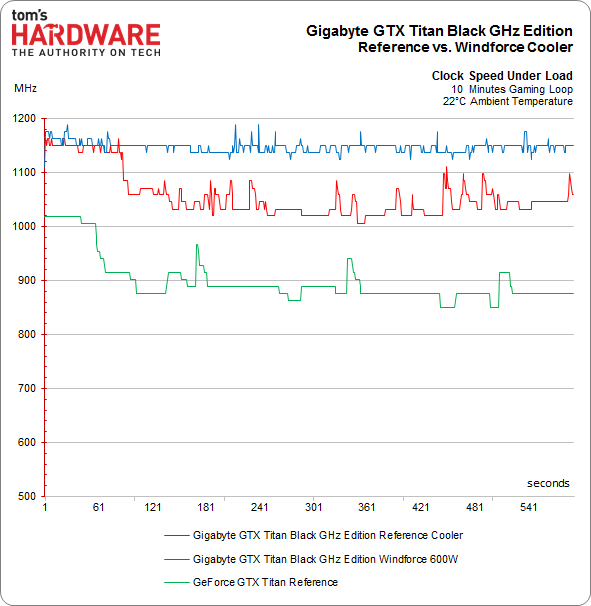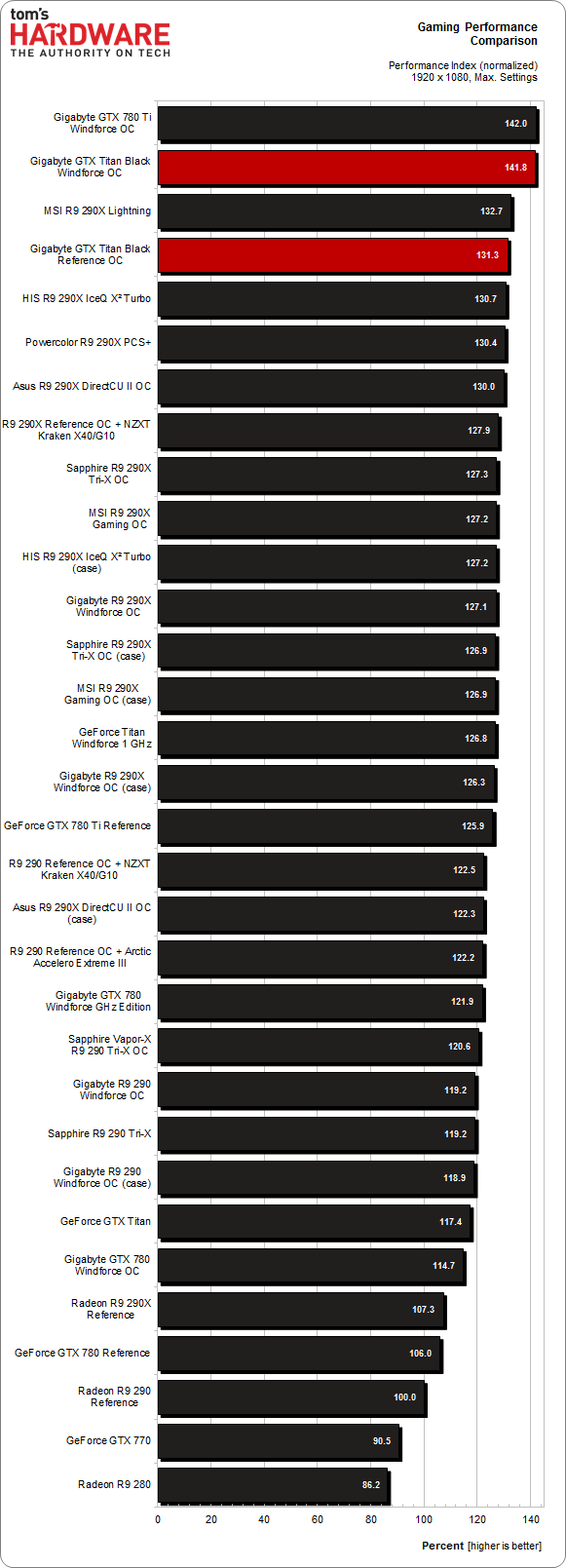Gigabyte GeForce GTX Titan Black: Do-It-Yourself Cooler Swap
Nvidia doesn’t allow its partners to sell the GeForce GTX Titan Black with proprietary cooling. However, Gigabyte now offers a GHz Edition of the card that comes bundled with its WindForce solution, which you can install on the overclocked board yourself.
Performance
Performance Benchmarks
We're in the process of adding Gigabyte's GeForce GTX Titan Black GHz Edition to our 2014 VGA Charts, which will facilitate a complete performance break-down, but I still wanted to touch on a normalized comparison in this review, also.
Additionally, I thought it'd be good to explore whether or not 6 GB of graphics memory makes a big difference in the benchmarks. Originally, it was believed that Nvidia's partners would start selling GeForce GTX 780 and 780 Ti cards with 6 GB, rather than 3 GB. There's currently one 780 from EVGA with 6 GB. However, plans for the 780 Tis were scrapped when it became clear they'd cannibalize sales of Titan Black amongst affluent enthusiasts.
GPU Boost Frequency Under Load
We've gone into great depth about how Nvidia's GPU Boost technology works in theory and practice, so let's compare the company's reference GeForce GTX Titan, an overclocked Gigabyte GeForce GTX Titan Black, and the overclocked Gigabyte card with its modified cooler.
The overclocked Gigabyte board with Nvidia's reference cooler hangs out well under its 1100 MHz ceiling. In fact, the average frequency barely hovers around 1050 MHz. The modified version is quite a bit faster, averaging 1150 MHz. That's a gain of about 100 MHz, with lower temperatures and less noise to boot. Nvidia's reference GeForce GTX Titan really can’t compete. The overclocked Gigabyte model with its WindForce cooler lands just behind the Gigabyte GeForce GTX 780 Ti WindForce OC‘s Boost clock frequency of almost 1170 MHz.
We’re using the 1080p benchmarks of our VGA charts at higher (in fact, the highest possible) settings for our normalized performance benchmarks.
Comparison between 1080p and 2160p: Are 6 GB Worth It?
If you go by the performance benchmarks, 6 GB doesn't appear necessary at all. There's barely a difference between the two configurations. This is complicated by the fact that a single-GPU configuration still can't really handle 3840x2160. In order to enjoy the highest resolutions and most demanding detail settings, you want a couple of high-end cards in SLI or CrossFire. To keep the comparison fair, I overclocked the modified Gigabyte GTX Titan Black GHz Edition with the WindForce cooler to the same 1020 MHz base clock speed as the factory-overclocked Gigabyte GTX 780 Ti WindForce OC.
The head-to-head comparison paints a sobering picture. Apart from double-precision compute performance (for the handful of folks who actually need it), a similarly-clocked GeForce GTX 780 Ti is clearly the better choice, especially since it's a lot less expensive.
Get Tom's Hardware's best news and in-depth reviews, straight to your inbox.
Now, here's the wild card: 6 GB is very likely more important to an SLI configuration. I don't have the cards or the FCAT suite here to properly test such a decadent setup. However, I also know from Chris Angelini that a couple of 3 GB cards rendering cooperatively start to demonstrate stuttering artifacts at 2160p, particularly as you crank up the detail settings. In those cases, we think you'll lament the fact that there aren't any GeForce GTX 780 Ti 6 GB boards available.
Current page: Performance
Prev Page Temperatures And Noise Next Page Gigabyte Gets Its WindForce Cooler Right
Igor Wallossek wrote a wide variety of hardware articles for Tom's Hardware, with a strong focus on technical analysis and in-depth reviews. His contributions have spanned a broad spectrum of PC components, including GPUs, CPUs, workstations, and PC builds. His insightful articles provide readers with detailed knowledge to make informed decisions in the ever-evolving tech landscape
-
ShadyHamster Reply13466306 said:So we have to change the cooler by our self? now thats wierd.
If you bothered reading the first page you'd know why. -
bloodgigas Reply13466306 said:So we have to change the cooler by our self? now thats wierd.
If you bothered reading the first page you'd know why.
"Nvidia doesn’t allow its partners to sell the GeForce GTX Titan Black with proprietary cooling. However, Gigabyte now offers a GHz Edition of the card that comes bundled with its WindForce solution, which you can install on the overclocked board yourself."
This one right? whats the difference between you install it yourself and Gigabyte take the initiative pre-factory installed? or Warranty Void? -
bloodgigas Reply13466306 said:So we have to change the cooler by our self? now thats wierd.
If you bothered reading the first page you'd know why.
"Nvidia doesn’t allow its partners to sell the GeForce GTX Titan Black with proprietary cooling. However, Gigabyte now offers a GHz Edition of the card that comes bundled with its WindForce solution, which you can install on the overclocked board yourself."
This one right? whats the difference between you install it yourself and Gigabyte take the initiative pre-factory installed? or Warranty Void? -
FormatC It is one of Nvidias funny rules.Reply
Ok, for your better understanding:
Nvidia doesn’t allow its partners to sell the GeForce GTX Titan Black with factory-installed proprietary cooling. -
envy14tpe If you are dropping the cash on a Titan I really wish people would go liquid cooling. Seems to be the best.Reply -
chaosmassive Nvidia doesnt permit to install any 3rd party cooling on their chip, now thats weird !Reply -
wolverine96 Very nice, Gigabyte! I almost wish I had bought one. I have one of those "out of stock ASUS cards from Newegg". I am not disappointed, though. The card handles 84 degrees Celsius just fine!Reply
Igor Wallossek, I wonder if you could put up a graph for 3D rendering? If you use Blender's BMW scene by Mike Pan (a popular benchmark scene), make sure you properly set the tile size! -
Damn_Rookie Reply
Silly question probably, but why does nVidia allow only EVGA to break this rule, with their hydro copper signature edition you mentioned? Is it just because it's a water cooled model? Do you think nVidia specially signs off on the design?13466699 said:It is one of Nvidias funny rules.
Ok, for your better understanding:
Nvidia doesn’t allow its partners to sell the GeForce GTX Titan Black with factory-installed proprietary cooling.
I'm genuinely curious.



